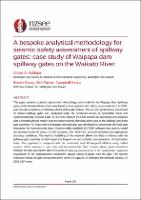A bespoke analytical methodology for seismic safety assessment of spillway gates: case study of Waipapa dam spillway on the Waikato River

Download
Date
2022-04-27Authors
Siddiqui, Umair
Parker, Will
Davey, Robert
Keepa, Campbell
Metadata
Show full item recordAbstract
This paper presents a seismic assessment methodology tailor-made for the Waipapa Dam Spillway gates on the Waikato River which were found to have potential dam safety issues under the 1 in 2500-year annual exceedance probability (AEP) earthquake actions. The seismic performance assessment of Radial Spillway gates was conducted under the combined actions of hydrostatic thrust and hydrodynamically induced loads. A 3D finite element PLAXIS model was developed and analysed with a selected ground motion suite to extract seismic demands at the base of the spillway and at the gate trunnions. An improved and bespoke methodology was developed to incorporate the fluid-gate interaction for hydrodynamic loads. Commercially available SAP2000 software was used to model the upstream reservoir using 3D solid elements with ‘fluid-like’ material properties and appropriate boundary conditions. The explicit modelling of the reservoir allows the fluid to interact with the spillway-gate assembly at their respective frequencies and includes auto-generation of hydrostatic loads. This approach is compared with the commonly used Westergaard Method using ‘added masses’ which assumes a rigid dam and incompressible fluid. Results shows good correlation between the two approaches and the benefit of reducing conservatism in the ‘added mass’ approach assumption of the hydrodynamic component always acting in-phase with the gate. The seismic evaluation found the gate components have sufficient capacity to withstand the demands during 1 in 2500 AEP event.
